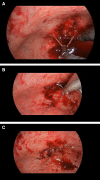Transvesical laparoendosopic single-site surgery as a valuable option to remove eroded materials from the bladder: single-center experience and a review of the literature
- PMID: 30478813
- PMCID: PMC6394444
- DOI: 10.1007/s11255-018-2039-y
Transvesical laparoendosopic single-site surgery as a valuable option to remove eroded materials from the bladder: single-center experience and a review of the literature
Abstract
Introduction: Currently, polypropylene materials are used widely for the treatment of various urogynecologic disorders. This type of treatment can be complicated, although rarely, with erosions of the polypropylene implants into the bladder or the urethra. There is no established treatment for such complications. We present our experience in transvesical laparoendoscopic single-site surgery (T-LESS) removal of eroded materials, and a review of the literature in this field.
Materials and methods: From June 2015 to May 2017 eight females, with an average age of 66.5 years (range 55-80 years), were referred to our Center because of the erosion of polypropylene material in the bladder, after anti-incontinence or pelvic organ prolapse treatment. Patients were diagnosed with ultrasound and cystoscopy. Seven bladder erosions and one bladder and urethral penetration were found. Patients were qualified for removal with the T-LESS approach. The Tri-Port + disposable set and standard laparoscopic instruments were used. The eroded materials were dissected and cut away, and the defects of the bladder wall were closed with barbed sutures. The peri-operative efficacy and safety of the method were assessed, and the patients were scheduled for follow-up visits at 6 weeks and every 3 months thereafter. The patients were offered a cystoscopic exam during the 7-10 month period after the operation.
Results: The procedures were completed successfully in all patients. No blood loss or complications were observed. The mean operative time was 54.5 min, and the average hospital stay was 30 h. During a follow-up at 11 months, all patients were cured, except for one who presented urethral erosion.
Conclusions: The T-LESS technique for removal of eroded meshes is a safe and effective method. The precise access to the bladder minimizes morbidity, and suturing the bladder wall defects may reduce the risk of recurrence.
Keywords: Complications; Laparoendoscopic single-site surgery; Surgery; Urinary incontinence.
Conflict of interest statement
Conflict of interest
Maciej Przudzik, Michał Borowik, Mirosław Łesiów, and Roman Łesiów declares that they have no conflict of interest.
Research involving human participants or animals
This article does not contain any studies with human participants or animals performed by any of the authors.
Figures



Similar articles
-
[Erosions of the vaginal, bladder and urethral mucosa after transvaginal correction of genital prolapse and stress urinary incontinence using synthetic materials].Urologiia. 2013 Jul-Aug;(4):12-5. Urologiia. 2013. PMID: 24159757 Russian.
-
Transvesical laparoendoscopic single site surgery to remove surgical materials penetrating the bladder: initial clinical experience in 9 female patients.J Urol. 2013 Sep;190(3):909-15. doi: 10.1016/j.juro.2013.03.027. Epub 2013 Mar 14. J Urol. 2013. PMID: 23499744
-
Laparoscopic transvesical excision and reconstruction in the management of mid-urethral tape mesh erosion and stones around the bladder neck: initial experiences.BJU Int. 2012 Dec;110(11 Pt C):E1009-13. doi: 10.1111/j.1464-410X.2012.11563.x. Epub 2012 Oct 9. BJU Int. 2012. PMID: 23046315
-
[Bladder injury during sling operation in the treatment of SUI--review of literature and case report].Ginekol Pol. 2012 Oct;83(10):784-8. Ginekol Pol. 2012. PMID: 23383566 Review. Polish.
-
Consensus Statement of the European Urology Association and the European Urogynaecological Association on the Use of Implanted Materials for Treating Pelvic Organ Prolapse and Stress Urinary Incontinence.Eur Urol. 2017 Sep;72(3):424-431. doi: 10.1016/j.eururo.2017.03.048. Epub 2017 Apr 14. Eur Urol. 2017. PMID: 28413126 Review.
Cited by
-
Robot‑assisted surgical management of mid‑urethral sling erosion into the bladder using transperitoneal robotic extensive approach for total mesh excision.Wideochir Inne Tech Maloinwazyjne. 2025 Mar 21;20(1):118-123. doi: 10.20452/wiitm.2024.17939. eCollection 2025 Apr 9. Wideochir Inne Tech Maloinwazyjne. 2025. PMID: 40547837 Free PMC article.
-
Laparoscopic removal of intravesically inserted transobturator tape.Int Urogynecol J. 2021 Dec;32(12):3309-3312. doi: 10.1007/s00192-021-04857-0. Epub 2021 Jun 11. Int Urogynecol J. 2021. PMID: 34115163
References
-
- Cosson M, Caquant F, Collinet P et al. Prolift mesh (Gynecare) for pelvic organ prolapse surgical treatment using the TVM group: a retrospective study of 687 patients. Communication in the ICS Meeting Montreal, 31 Aug 2005
MeSH terms
Substances
LinkOut - more resources
Full Text Sources
Medical

